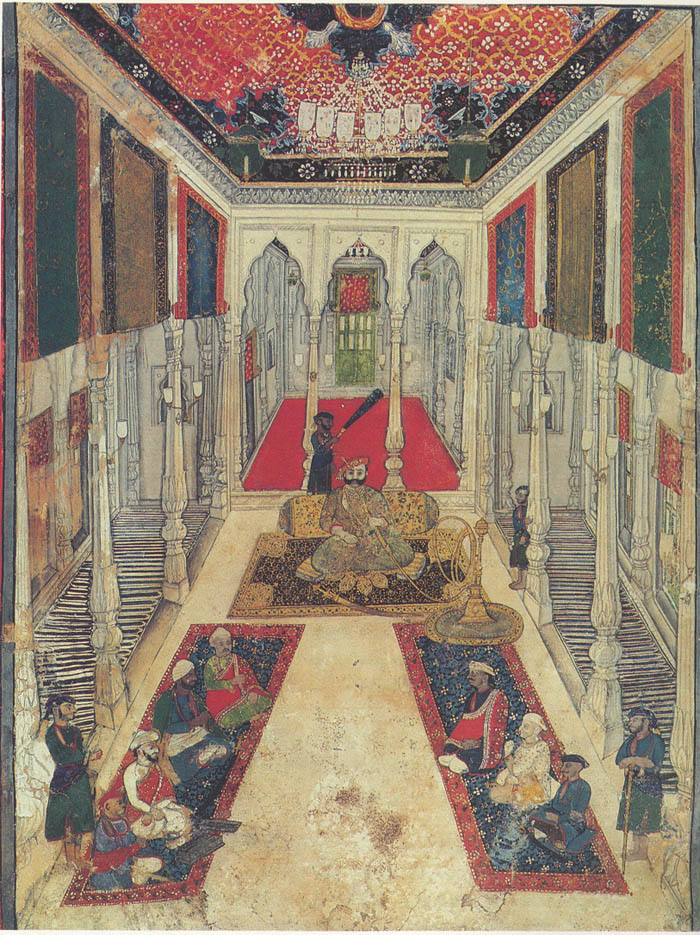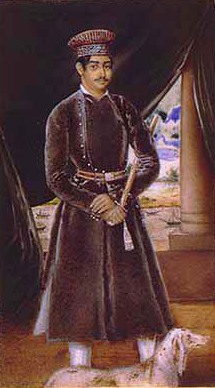|
Saranjamdar
A Saranjam is a grant of land (initially non-hereditary, sometimes hereditary) for maintenance of troops or for military service found among the Maratha, Brahmins, Rajput, Chandraseniya Kayastha Prabhu, Pathare Prabhu, and Kunbi communities in Maharashtra and the former Maratha administered regions of India, including territories in present-day Karnataka and Madhya Pradesh. The grant was bestowed by a king or regional ruler of a princely state. The Saranjam system may be a form of to the Jagir (feudatory estate) system. The land was mostly in the form of a rural Watan (rights given in reward for previous service or merit) or Jagir, its owner being entitled to extract revenue from the villages included in the territory. Saranjamdar was the title given to the landlord or holder of a Saranjam. It was usually bestowed on that person for heroic deeds in the military field, thus most Saranjamdars were former military officers. He may be a jagirdar, always ranking as a vassal. ... [...More Info...] [...Related Items...] OR: [Wikipedia] [Google] [Baidu] |
Jagir
A jagir (), ( Hindustani: जागीर/جاگیر, ''Jāgīr''), ( Marathi: जहागीर, ''Jahāgīrá'') also spelled as jageer, was a type of feudal land grant in the Indian subcontinent at the foundation of its Jagirdar ( Zamindar) system. It developed during the Islamic era of the Indian subcontinent, starting in the early 13th century, wherein the powers to govern and collect tax from an estate was granted to an appointee of the state. 13th-century origin and successors This feudal system of land ownership is referred to as the ''jagirdar'' system. The system was introduced by the Sultans of Delhi from the 13th century onwards, was later adopted by the Mughal Empire, the Maratha Empire and continued under the British East India Company. Some Hindu jagirdars were converted into Muslim vassal states under Mughal imperial sway, such as the nawabs of Kurnool. Most princely states of India during the colonial British Raj era were jagirdars such as Mohrampur Jagi ... [...More Info...] [...Related Items...] OR: [Wikipedia] [Google] [Baidu] |
Maratha
The Marathi people (; Marathi: , ''Marāṭhī lōk'') or Marathis (Marathi: मराठी, ''Marāṭhī'') are an Indo-Aryan ethnolinguistic group who are native to Maharashtra in western India. They natively speak Marathi, an Indo-Aryan language. Maharashtra was formed as a Marathi-speaking state of India on 1 May 1960, as part of a nationwide linguistic reorganisation of the Indian states. The term "Maratha" is generally used by historians to refer to all Marathi-speaking peoples, irrespective of their caste; However, it may refer to a Maharashtrian caste known as the Maratha which also includes farmer sub castes like the Kunbis. The Marathi community came into political prominence in the 17th century, when the Maratha Empire was established by Shivaji in 1674. Etymology According to R. G. Bhandarkar, the term Maratha is derived from Rattas, a tribe which held political supremacy in the Deccan from the remotest time. The Rattas called themselves ''Maha Rattas ... [...More Info...] [...Related Items...] OR: [Wikipedia] [Google] [Baidu] |
British India
The provinces of India, earlier presidencies of British India and still earlier, presidency towns, were the administrative divisions of British governance in South Asia. Collectively, they have been called British India. In one form or another, they existed between 1612 and 1947, conventionally divided into three historical periods: *Between 1612 and 1757, the East India Company set up "factories" (trading posts) in several locations, mostly in coastal India, with the consent of the Mughal emperors, Maratha Empire or local rulers. Its rivals were the merchant trading companies of Portugal, Denmark, the Netherlands, and France. By the mid-18th century three ''Presidency towns'': Madras, Bombay and Calcutta, had grown in size. *During the period of Company rule in India, 1757–1858, the Company gradually acquired sovereignty over large parts of India, now called "Presidencies". However, it also increasingly came under British government oversight, in effect sharing sovereig ... [...More Info...] [...Related Items...] OR: [Wikipedia] [Google] [Baidu] |
Indian Feudalism
Indian feudalism refers to the Examples of feudalism, feudal society that made up History of India, India's social structure Independence of India, until the formation of the Republic of India in the 20th century. Terminology Use of the term feudalism to describe India applies a concept of medieval European origin, according to which the landed nobility held lands from the Crown in exchange for military service, and vassals were in turn tenants of the nobles, while the peasants (villeins or serfs) were obliged to live on their lord's land and give him homage, labor, and a share of the produce, notionally in exchange for military protection. The term Indian feudalism is used to describe taluqdars, zamindars, and jagirdars. Most of these systems were abolished after the Indian independence movement, independence of India and the rest of the subcontinent. Damodar Dharmananda Kosambi, D. D. Kosambi and Ram Sharan Sharma, R. S. Sharma, together with Daniel Thorner, brought peasants ... [...More Info...] [...Related Items...] OR: [Wikipedia] [Google] [Baidu] |
List Of Maratha Dynasties And States
This is a list of Maratha dynasties and Maratha princely states in the Indian subcontinent. Maratha States The Maratha Salute state and Head of State by precedence * Baroda, title Maharaja Gaikwad, Hereditary salute of 21-guns * Gwalior, title Maharaja Shinde, Hereditary salute of 21-guns * Indore (Holkar State), title Maharaja Holkar, Hereditary salutes of 19-guns * Kolhapur State, title Maharaja Bhonsle Chhatrapati, Hereditary salutes of 19-guns * Dewas State (1728–1948) of Pawar clan. ** Dewas State Senior, title Maharaja, Hereditary salute of 15-guns ** Dewas State Junior, title Maharaja, Hereditary salute of 15-guns * Sangli, title Raja, Hereditary salute of 11-guns * Bhor (Gandekar State), title Raja, Hereditary salute of 9-guns * Jawhar State, title Maharaja, Hereditary salute of 9-guns * Sawantwadi State, title Raja, Hereditary salute of 9-guns * Mudhol State, title Raja, Hereditary salute of 9-guns Non-salute states Non-salute Maratha states, alphabetically ... [...More Info...] [...Related Items...] OR: [Wikipedia] [Google] [Baidu] |
Zamindar
A zamindar in the Indian subcontinent was an autonomous or semi-autonomous feudal lord of a ''zamindari'' (feudal estate). The term itself came into use during the Mughal Empire, when Persian was the official language; ''zamindar'' is the Persian for ''landowner''. During the British Raj, the British began using it as a local synonym for "estate". Zamindars as a class were equivalent to lords and barons; in some cases, they were independent sovereign princes. Similarly, their holdings were typically hereditary and came with the right to collect taxes on behalf of imperial courts or for military purposes. During the Mughal Empire, as well as the British rule, zamindars were the land-owning nobility of the Indian subcontinent and formed the ruling class. Emperor Akbar granted them mansabs and their ancestral domains were treated as jagirs. Most of the big zamindars belonged to the Hindu high-caste, usually Brahmin, Rajput, Bhumihar, or Kayastha. During the colonial era, ... [...More Info...] [...Related Items...] OR: [Wikipedia] [Google] [Baidu] |
Patil (title)
The Patil (Hindi: पाटिल) (meaning "village headman") is an Indian last name and a title or surname. The female variant of the title is ''Patlin'' or ''Patlinbai'', and is also used to describe the wife of a Patil. In ancient times, a Patil was the head of a village working under a Deshmukh who was head of the district. Under Deccan sultanates, and the Maratha Empire, the Patil was the village headman and the most important Vatandar of the village. His main duties were to be the collector of revenue, as well as being the head of police and justice. In Konkan, a Patil was called "Khot". Historian Ness writes that "what the Patil and Kulkarni were to a village, the Deshmukh or Deshpande were to the district, or Pargana". Patil settled villages and collected revenues from the villagers, thus a Patil family typically owned 80-90 percent of village land. Colonising multiple villages promoted a Patil to a Deshmukh. The Patil was entitled to several free services from vill ... [...More Info...] [...Related Items...] OR: [Wikipedia] [Google] [Baidu] |
Mansabdar
The Mansabdar was a military unit within the administrative system of the Mughal Empire introduced by Akbar later used in all over in early modern India. The word ''mansab'' is of Arabic origin meaning rank or position. The system determined the rank and status of a government official and military generals. Every civil and military officer was given a mansab, which determined their salaries and allowances. The term mansabdar means a person having a mansab. (which means a role) In the mansabdari system founded by Akbar, the mansabdars were military commanders, high civil and military officers, and provincial governors. Those mansabdars whose rank was one thousand or below were called Amir, while those above 1,000 were called Amir-al Kabir (Great Amir). Some great Amirs whose ranks were above 5,000 were also given the title of Amir-al Umara (Amir of Amirs). It was a system whereby nobles were granted the rights to hold a jagir, or revenue assignment (not land itself), for servic ... [...More Info...] [...Related Items...] OR: [Wikipedia] [Google] [Baidu] |
Naik (military Rank)
Naik (Nk; Hindustani: नायक ( Devanagri); نائیک ( Nastaliq )), also historically spelled as ''nayak'', is an Indian Army and Pakistan Army rank equivalent to corporal Corporal is a military rank in use by the armed forces of many countries. It is also a police rank in some police services. The rank is usually the lowest ranking non-commissioned officer. In some militaries, the rank of corporal nominally corr .... The rank was previously used in the British Indian Army and the Camel Corps, ranking between lance naik and havildar. In cavalry units, the equivalent is lance daffadar. Like a British corporal, a naik wears two rank chevrons. A naik leads a team of 8-10 soldiers. See also * Army ranks and insignia of India * Army ranks and insignia of Pakistan References External links * Military ranks of British India Pakistan Army ranks Military ranks of the Indian Army {{Mil-rank-stub ... [...More Info...] [...Related Items...] OR: [Wikipedia] [Google] [Baidu] |
Inamdar (feudal Title)
Inamdar was a feudal title prevalent before and during British Raj, including during the Maratha rule of Peshwa The Peshwa was the second highest office in the Maratha Empire, next in rank and prestige only to that of the Chhatrapati. Initially serving as the appointed prime minister in the Maratha Kingdom, the office became hereditary when Shahu gave t ..., Deccan Sultanate, Bahamani Kingdom and other rulers of India. The title was bestowed upon to the person who received lands as ''Inam'' (grant or as a gift), rewarding the extraordinary contribution rendered to the ruler or the princely state. Inam Land is defined as Land held as a gift or grant by a Nizam or any Jagirdar is called Inam Land. In the colonial age, the British enacted several laws which defined rights and obligations of Inamdar in their territories, like the Madras Inams Act VIII of 1869. There was a separate post of Inam Commissioner to look after revenue and records of Inam lands. There were certain I ... [...More Info...] [...Related Items...] OR: [Wikipedia] [Google] [Baidu] |




